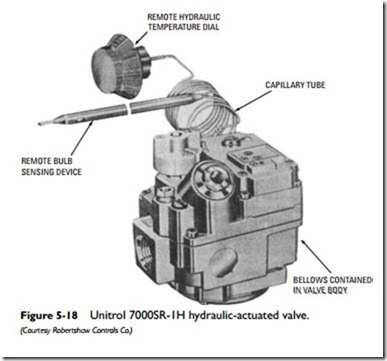Diaphragm Valves
The following are the three principal diaphragm valves, each distinguished by the kind of power used to actuate them:
• Hydraulic-actuated valves
• Solenoid-actuated valves
• Heat-motor-actuated valves
A hydraulic-actuated valve utilizes a hydraulic element to provide both the thermostatic sensing means and the power for valve opera- tion. The closed hydraulic sensing and actuating device consists of a bulb, capillary tube, and a bellows or diastat (see Figure 5-18). Temperature changes cause the liquid in the remote-bulb sensing device to expand or contract. This expansion or contraction of the liquid operates the valve by controlling the pressure exerted against a bellows in the valve body. Additional information about this type of valve is contained in the section Remote-Bulb Thermostats in Chapter 4 (Thermostats and Humidistats).
Both solenoid-actuated diaphragm valves and heat-motor-actuated diaphragm valves are described elsewhere in this chapter (see Solenoid Gas Valves, Oil Valves, and Direct-Acting Heat Motor Valves).
The term diaphragm valve can be confusing because valves that use a diaphragm are usually referred to by the power used to actu- ate them (e.g., hydraulic-actuated valves, solenoid-actuated valves) or their specific function (e.g., electric gas valves, oil burner valves).
A diaphragm valve is any valve that contains a diaphragm; its purpose is to respond to pressure variations. Because this is an essential feature of pressure regulators, the operating principles of a diaphragm valve are described in the sections Gas-Pressure Regulators and Combination Gas Controls.
